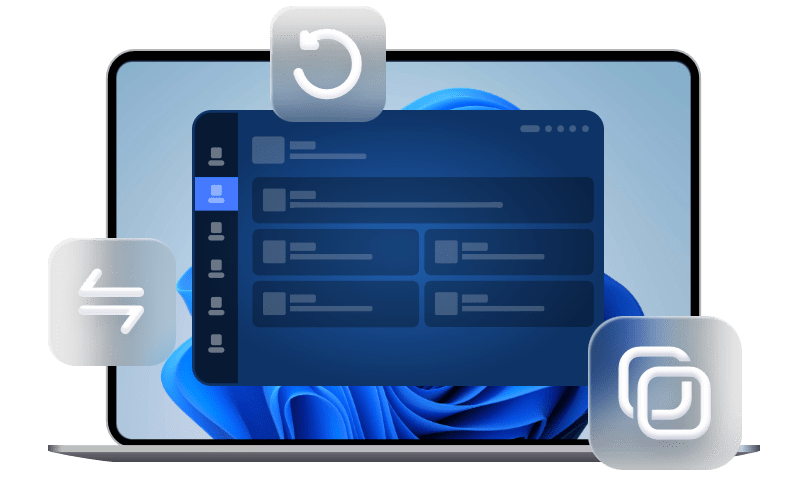QNAP to QNAP Backup: Full Guide [3 Methods]
You can easily perform QNAP to QNAP backup with QNAP Hybrid Backup Sync, SnapshotReplica, or third-party backup software - AOMEI Backupper. Scroll down to explore more!
What Is QNAP to QNAP Backup?
QNAP-to-QNAP backup simply means copying data from one QNAP NAS to another. Instead of relying only on a single NAS or cloud storage, you create a redundant copy of your files, snapshots, or system data on another QNAP device, either on the same network or in a remote location, usually over protocols like RTRR, Rsync, FTP, or SMB.
You can run backups manually, schedule them automatically, or use incremental replication to copy only changed data - saving storage and time. Many users also set up offsite backups to a second NAS at home, work, or a remote server for disaster recovery.
Pros of Backing Up One QNAP to Another
Here are 5 possible reasons behind QNAP to QNAP backup:
- Fast data transfer: Backing up over LAN or VPN is much faster than cloud uploads.
- Local control: You own both devices, so you avoid cloud storage limits, bandwidth caps, or subscription fees.
- Better security: All data stays on your hardware. You can enable encryption, permissions, and secure transfer protocols.
- Quick recovery: If the first NAS fails, files can be restored instantly from the second one - no downloading from the cloud.
- Works for large files: Great for heavy workloads like videos, virtual machines, and surveillance storage.
Method 1: Perform QNAP to QNAPBackup Using HBS3 (Hybrid Backup Sync)
HBS3 is the easiest and most flexible way to perform QNAP-to-QNAP backups. With it, you can back up shared folders, apps, system settings, and even snapshots- keeping your second NAS perfectly in sync.
It offers users 4 protocols to transfer data - RTRR is best for QNAP-to-QNAP, and supports real-time, scheduled, and incremental backups, making it ideal for both local and remote QNAP devices.
👉What do you need:
✅ Install Hybrid Backup Syncon on both QNAPs. You can open App Center and search for Hybrid Backup Sync
✅ Open HBS 3 in the destination QNAP NAS, and enable RTRR Server in the "Services" pane. Or enable Rsync Server for cross-
After everything is ready, go to the source QNAP and set up QNAP to QNAP backup.
Step 1. On the source QNAP, go to Backup & Restore. Then, click Backup Up Now and select New Backup Job.
Step 2. In the Source folders box, select one or more folders to back up. Click Next.
Step 3. You will then be asked to create a destination storage space.
- Check the Remote NAS and click Select.
- Enter the hostname, IP address, port, and password. Be sure to select the account access - RTRR.
- Click Create.
Step 4. In the Destination folder box, select a shared folder and click OK.
Step 5. Click Scheduler > + to set up a schedule (e.g., daily, weekly, or monthly) and enable version management - simple or smart versioning.
Step 6. Click Rules to enable filters, advanced settings, and other options. Click Next.
Step 7. Confirm all the backup settings and click Create.
Step 8. In the Backup & Restore screen, click Back Up Now.
Method 2: Perform QNAP to QNAP Backup using Snapshot Replica
Snapshot Replicais another powerful tool to perform QNAP-to-QNAP backups, especially when you want full data protection with version control. Instead of just copying files, it replicates snapshots- point-in-time images, e.g., individual shared folders, entire volumes, LUNs - for iSCSI storage, to another QNAP device. It’s fast, space-efficient, and ideal for preventing data loss from ransomware or accidental deletion.
👉 Prerequisites:
✅ Both QNAPs must support snapshots (Storage & Snapshots > Snapshot), have at least 1GB memory, and open SSH port 22 and TCP data ports 50100-50199.
✅ The remote NAS must allow SSH connections (in Control Panel>Network & File Servers>Telnet / SSH).
Step 1. On the Main Menu, Click Storage & Snapshots. Then, scroll down to Snapshot Backup, click Snapshot Replica.
Step 2. Click Create a Replication Job.
Step 3. Under the Select Source tab, select a shared folder and enter a task name.
Step 4. Under the Select Destination tab, enter the Destination hostname/IP address, user name, password, and click Test.
You'll be asked to select a storage pool.
Step 5. Under the Backup Plan tab, select a backup plan, schedule, and configure the time, day, frequency, and repeat pattern.
Step 6. Under the Configure tab, choose whether to encrypt, compress, and set the maximum transfer speed. Then, click Next > Finish.
Method 3: Perform QNAP to QNAP Backup using AOMEI Backupper
If you want an easier way to backup QNAP to QNAP, AOMEI Backupper Standard will be the best choice. It’s free and fully compatible with Windows 11, 10, 8/8.1, and 7.

- With a user-friendly interface, even beginners can use it easily and quickly.
- Flexible Backup: Backup any files or folders, whether it’s on local drives, external drives, network drives, NAS, etc.
- Multi Scheduling: Backup files based on daily, weekly, monthly, or event triggers, minimizing heavy human intervention.
- Auto & space-saving: Include features like incremental backups, compression, splitting, etc, greatly saving backup time and space. All features are default-enabled and adjustable.
Step 1. Open AOMEI Backupper Standard after installing. Then, go to Backup > File Backup.
Step 2. Click Select Source > Add Folder/File.
To perform QNAP to QNAP backup, please click Share/NAS.
Then, click Add NAS and enter the network path of the source QNAP.
Step 3. Click the PC icon > NAS > enter the network path of the destination QNAP.
Step 4(Important). All the space-saving features will be enabled automatically. Click Options to change it if needed. Click Schedule to enable daily, weekly, monthly, etc., or event triggers. Confirm and click Start Backup to start QNAP to QNAP backup in Windows 10 or 11.
✅ Tip: You can also enable differential backups or cleanup methods in the advanced edition to save much time and storage space on future backups.
FAQs
1. Can I back up to a remote QNAP over the internet?
Yes. You can back up to another QNAP outside your local network by using VPN, myQNAPcloud, or port forwarding. HBS3 supports secure remote replication through RTRR, Rsync, and encrypted connections. This allows you to keep an offsite copy of your data for disaster recovery.
2. Is QNAP to QNAP faster than cloud backup?
In most cases, yes. Backing up to another QNAP, especially on the same LAN, can be much faster than uploading to cloud storage. Even remote QNAP-to-QNAP backups are typically faster since they send incremental changes, not full file copies, and avoid cloud bandwidth limits.
3. Can I encrypt NAS-to-NAS backups?
Yes. HBS3 supports encryption for data in transit and at rest. You can enable encrypted transmission during RTRR or Rsync jobs, and encrypt backup data stored on the destination QNAP. This keeps your files secure during transfer and storage, even if the remote NAS is outside your home or office.
4. Can I restore data directly from the destination QNAP?
Yes. If your source NAS fails or data is lost, you can restore directly from the destination QNAP. HBS3 allows full restore, folder-level restore, or version-level restore if snapshots or versioning were enabled. You can restore over the network or by physically moving the drives/NAS, depending on your setup.
5. Do NAS-to-NAS backups support incremental or versioned backups?
Absolutely. Both HBS3 and Snapshot Replica support incremental backups, meaning only changed data is transferred- saving time and bandwidth. You can also keep multiple backup versions, making it easy to roll back if files are corrupted, encrypted by ransomware, or accidentally deleted.
Conclusion
QNAP Hybrid Backup Sync, Snapshot Replica, and AOMEI Backupper are QNAP to QNAP backup software, but different. HBS3 is the easiest and most flexible built-in tool, while Snapshot Replica is best for preventing data loss from ransomware or accidental deletion.
In contrast, AOMEI Backupper is much easier to use as long as you have full access to both QNAP and there is a shared folder without complex setup. It also offers automatic backup, incremental backup, and more.

